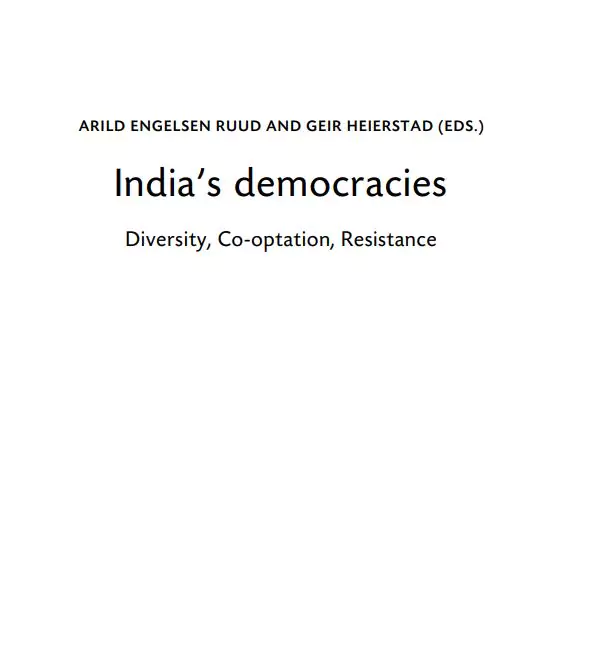‘Democracy In India’ PDF Quick download link is given at the bottom of this article. You can see the PDF demo, size of the PDF, page numbers, and direct download Free PDF of ‘Democracy In India’ using the download button.
Democracy In India PDF Free Download

Democracy In India
Indian political system
India’s government is loosely modeled on the British Westminster system. It consists of a president as head of state; an executive headed by the prime minister; a legislature consisting of a parliament with an upper and lower house (the Rajya Sabha and Lok Sabha); and a judiciary with a supreme court at its head.
543 members are elected to the Lok Sabha through a first-past-the-post general election, held every five years. State representatives are indirectly elected to the Rajya Sabha on staggered six–year terms, so every two years around one-third are changed, and elected by state legislatures.
India’s constitution sets out the country’s political code, federal structure, and powers of government and guarantees Indians’ rights, including equality before the law and freedoms of speech, assembly, movement, and others.
The system is complicated by India’s caste system, a hierarchical social structure that divides the Hindu majority into groups, with ‘Brahmins’ at the top and ‘Dalits’ at the bottom of society. Last names often indicate to which caste a person belongs.
India’s constitution banned caste discrimination and early governments introduced quotas to provide a fairer allocation of jobs and education, but caste remains a powerful factor in politics. In some regions, political parties still court voters according to castes, who tend to vote as a block.
Secularism and Democracy in India
India’s constitution was adjusted to describe it as a secular state during the 1975 emergency, and a later court ruling found that India has been secular since independence. But India is understood to be a deeply religious country, with diverse religions represented in its population.
The constitution is secular in that it prohibits the persecution of individuals for their religious beliefs
The Constitution is secular in that it prohibits the persecution of individuals for their religious beliefs, but it does not specifically separate church and state in the fashion of the United States Constitution.
Religion is an important factor in Indian politics with politicians courting votes by caste or religious affiliation.
For more than a century, Hindu nationalists have called for the country to be redefined as a Hindu homeland.
Features of democratic government in India
Features of democratic government in India from the beginning of the democratic system in India are as follows –
- Collective Responsibility
In the democratic government in India, both the center and state, the Council of Ministers to their respective legislatures are collectively responsible. For any act by the government, the entire ministers of the council are responsible, and not a single minister alone.
- Majority Rules
Majority rule is one of the main features of Indian democracy. The party which forms the government needs to get the majority number of votes in the election. This is the majority rule and every citizen of the country must support and accept the government that got the majority number of votes from the citizens.
- Opinions of the minority are respected
Though Indian democracy has the feature of majority rules opinions of minorities are also considered. Minorities are also asked to give their opinions on any field. As India is a democratic form of government so both positive and negative criticisms are taken into consideration and minorities’ opinions must be tolerated by majorities.
- Provisions for Rights
Indian democratic government provides several rights to the individual. These rights include the Right to Education, Freedom of speech and expression, the Right to form a union or association, etc.
- Government that Compromise
Indian democracy is a form of government that considers the opinion of the ruling party as well as the other parties. It is a type of government that compromise and adjusts.
- Independent Judiciary
The Independent judiciary is another feature of democratic government. Independent judiciary means that in a democratic form of government, the judiciary need not depend on the legislature or executive.
- Political equality
Indian democracy is based on political equality, which means every citizen of India is equal before the law and has the right for voting irrespective of class, creed, caste, race, sex, and religion.
| Language | English |
| No. of Pages | 253 |
| PDF Size | 1.42 MB |
| Category | Education |
| Source/Credits | – |
Related PDFs
Democracy And Education PDF By John Dewey In English
Bholi Class 10 Questions And Answers PDF
Class 10 Science Chapter 9 Heredity and Evolution Notes PDF
Weather, Climate, And Adaptations Of Animals To Climate Class 7 Science Notes Chapter 7 PDF
Silk Road Class 11 Questions And Answers PDF
Democracy In India PDF Free Download
